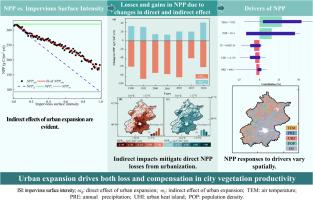Urban expansion drives both loss and compensation in city vegetation productivity
IF 6.3
2区 环境科学与生态学
Q1 ENVIRONMENTAL SCIENCES
引用次数: 0
Abstract
Urbanization alters vegetation productivity by both direct (ωd) and indirect (ωi) effects. The direct effect is from the change of vegetated area indicated by impervious surface intensity (ISI), while indirect effects arise from changes in urban environmental factors, such as near-surface air temperatures, precipitation, urban heat island (UHI) intensity, and population density (POP). The respective contributions of ωd and ωi to vegetation net primary productivity (NPP) under various phases of urbanization are not well quantified. Using multisource remote-sensing data from 1990 to 2020, we analyzed the spatiotemporal variation in urban expansion and the effect that ωd and ωi had on NPP in the megalopolis of Beijing, China, over 5-year intervals. During this period, Beijing underwent significant planar expansion rates of about 58.9 km2/yr. Annual mean loss of NPP by ωd was estimated to be about 77.1 g C/(m2·yr) during the 1990-2020 period, while annual mean improvement to NPP by ωi amounted to an increase of 28.9 g C/(m2·yr). The NPP losses were partially offset by NPP improvements in the order of 18.6 %-69.3 %. The impact of forcing variables on NPP varied spatially. Air temperature, precipitation, UHI, POP, and ISI explained about 13.8 %, 23.2 %, 23.7 %, 14.7 %, and 24.6 % of the spatial variation in NPP. The impact of air temperature on NPP was related to available moisture, negatively affecting NPP in regions with water deficits. Our findings demonstrate the dual impact of urbanization on vegetation and underscore the necessity for spatially adaptive ecological management strategies in regions experiencing rapid urban growth.

城市扩张既导致城市植被生产力的损失,也导致城市植被生产力的补偿
城市化通过直接效应(ωd)和间接效应(ωi)改变植被生产力。其直接影响来自不透水面强度(ISI)所表示的植被面积的变化,间接影响来自近地表气温、降水、城市热岛强度和人口密度等城市环境因子的变化。在不同城市化阶段,ωd和ωi对植被净初级生产力(NPP)的贡献没有很好的量化。利用1990—2020年的多源遥感数据,分析了北京特大城市城市扩张的时空变化特征,以及ωd和ωi对NPP的影响。在此期间,北京经历了58.9平方公里/年的显著平面扩张速度。1990-2020年期间,ωd对NPP的年平均损失约为77.1 g C/(m2·yr),而ωi对NPP的年平均改善相当于增加28.9 g C/(m2·yr)。NPP的损失部分被18.6% - 69.3%的NPP改善所抵消。强迫变量对NPP的影响存在空间差异。气温、降水、UHI、POP和ISI分别解释了NPP空间变化的13.8%、23.2%、23.7%、14.7%和24.6%。气温对NPP的影响与有效水分有关,对缺水地区的NPP有负向影响。我们的研究结果证明了城市化对植被的双重影响,并强调了在城市快速增长的地区采取空间适应性生态管理策略的必要性。
本文章由计算机程序翻译,如有差异,请以英文原文为准。
求助全文
约1分钟内获得全文
求助全文
来源期刊

Journal of Environmental Sciences-china
环境科学-环境科学
CiteScore
13.70
自引率
0.00%
发文量
6354
审稿时长
2.6 months
期刊介绍:
The Journal of Environmental Sciences is an international journal started in 1989. The journal is devoted to publish original, peer-reviewed research papers on main aspects of environmental sciences, such as environmental chemistry, environmental biology, ecology, geosciences and environmental physics. Appropriate subjects include basic and applied research on atmospheric, terrestrial and aquatic environments, pollution control and abatement technology, conservation of natural resources, environmental health and toxicology. Announcements of international environmental science meetings and other recent information are also included.
 求助内容:
求助内容: 应助结果提醒方式:
应助结果提醒方式:


